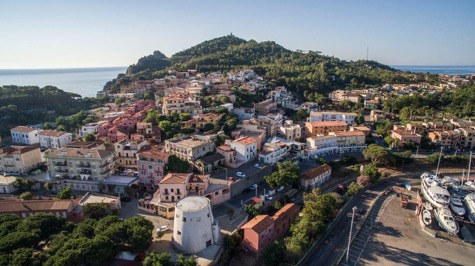The tower of San Miguel (San Michele)
Between the XVI and XVII century, in the central part of the East Sardinian coast, three lookout towers were built in Arbatax to defend and protect the territory against pirate raids. The towers of San Miguel and San Gemiliano are still visible; whilst the third one, called “di Largavista” was demolished in 1866 to make room for the Bellavista Lighthouse (fig. 1).

The tower of San Miguel, originally indicated in Arabic as “Arba a Tasciar”, the “fourteenth tower”, is said to have given its name to Arbatax which grew, over the years, right around it (figs. 2-3).


Built in the mid XVI century, it is a truncated cone in shape (diameter less than 15, more than 11 metres) and an imposing wall structure made from granite and porphyry blocks, 15 metres high (fig. 4).

The interior was divided into several levels: the cistern, the first floor and place-of-arms (terrace). The first floor, domed and sustained by a central pillar, housing the soldiers' lodgings and connected to the place-of-arms by a staircase inside the walls (fig. 5). This division was modified in the XIX century when the building became a Tax Police barracks and the terrace is now covered by a concrete floor.

The tower, guarding the port (fig. 6), had canons and mortars and suffered several attacks and landing attempts over the centuries. In 1846, they stopped using the building for lookout and defence purposes and it then became a barracks. Perfectly preserved and returned to its ancient splendour by recent restoration, the tower still has its old canons (fig. 7). The current access, with a concrete staircase surrounded by iron railings, was built in the XIX century.


Bibliografia
- V. NONNIS, Tortolì, in M. BRIGAGLIA, S. TOLA (a cura di), Dizionario storico geografico dei comuni della Sardegna, Firenze 2009, pp. 2060-2066.
- V. NONNIS, Tortolì, in AA.VV., Ogliastra. Antica Cultura, Nuova Provincia. I Paesi, Sestu-Bari Sardo 2005, pp. 143-153.
- M. RASSU, Sentinelle del mare. Le torri della difesa costiera della Sardegna, Dolianova 2005.
- M. RASSU, Tortolì – Torre di Arbatax, in Guida alle torri e forti costieri, Cagliari 2000, pp. 89-90.
- G. MONTALDO, Le torri costiere in Sardegna, Sassari 1992.
- F. FOIS, Torri spagnole e forti piemontesi in Sardegna, Cagliari 1981.

 VR
VR